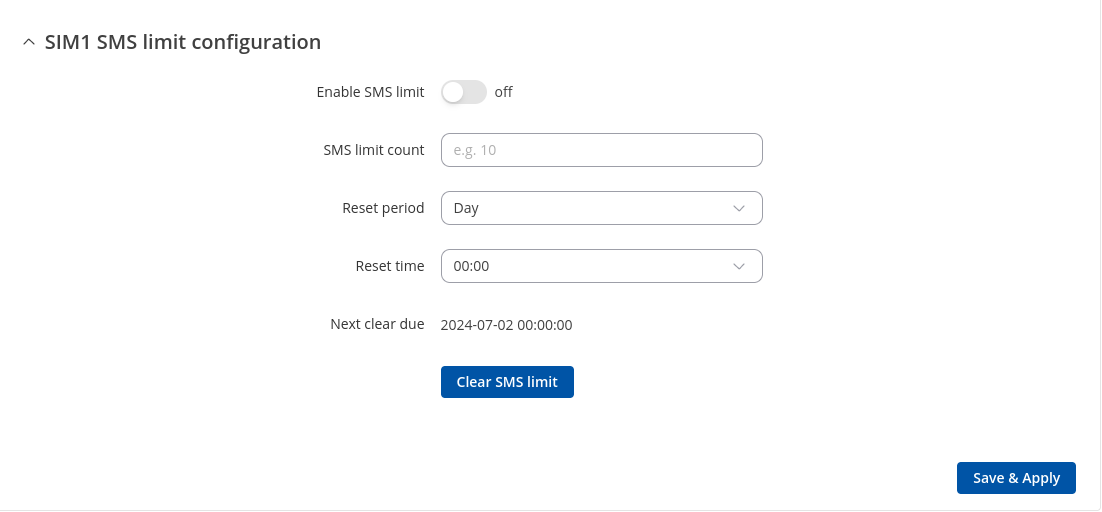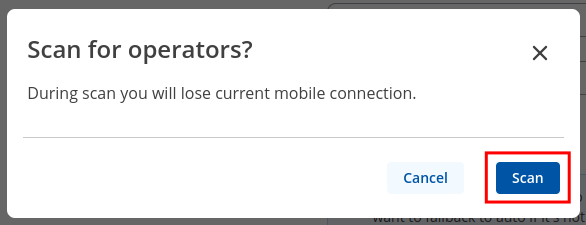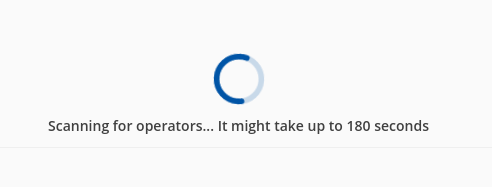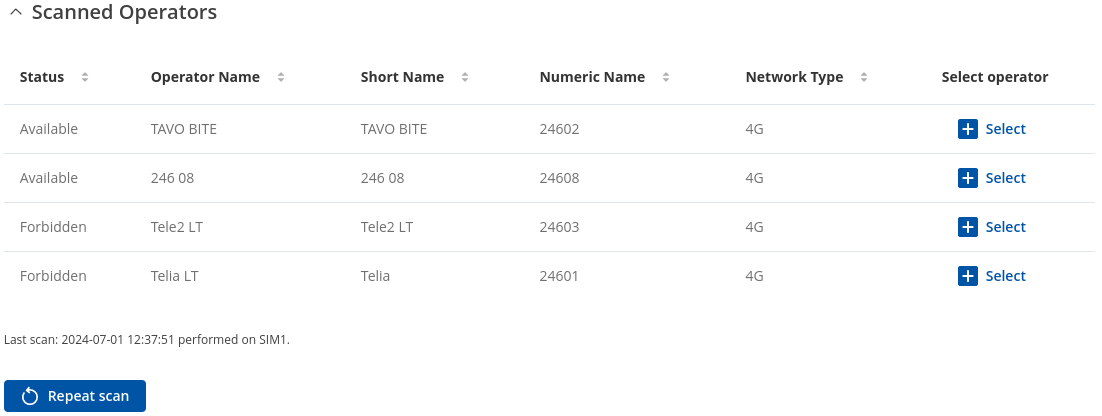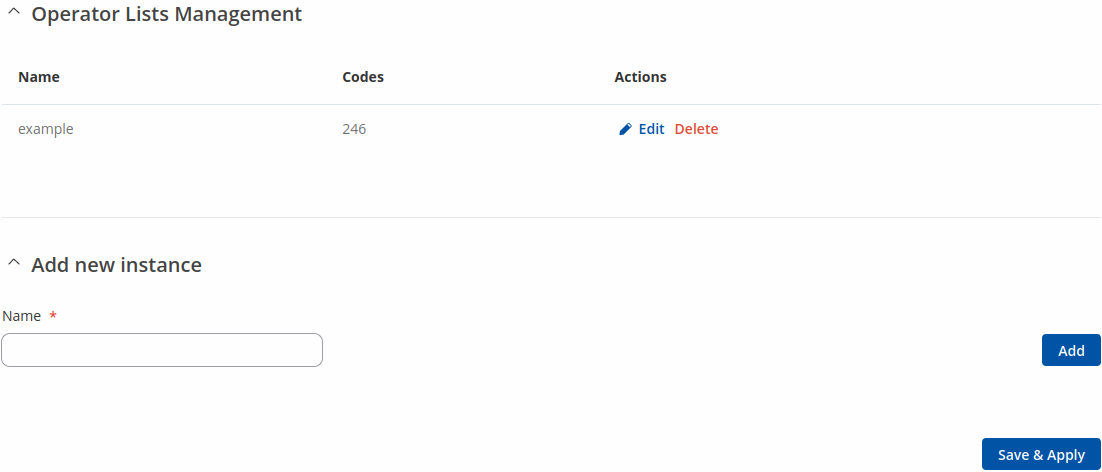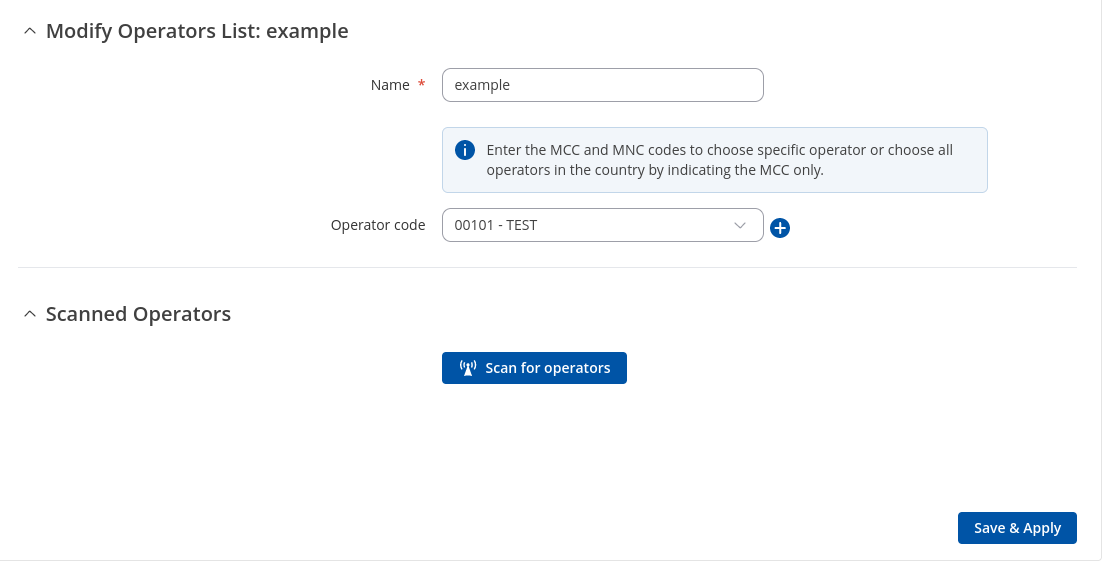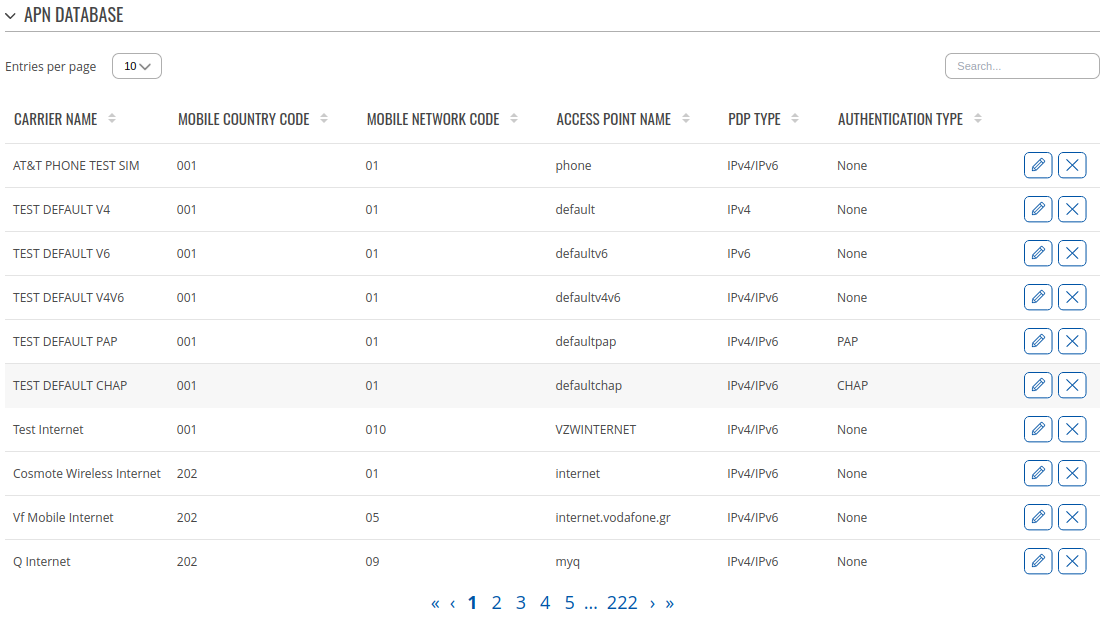Template:Networking rutos manual mobile: Difference between revisions
No edit summary |
No edit summary |
||
| (34 intermediate revisions by 3 users not shown) | |||
| Line 27: | Line 27: | ||
The <b>SIM Card Settings</b> section is used to configure main SIM card parameters. Refer to the figure and table below for information on the fields contained in that section. | The <b>SIM Card Settings</b> section is used to configure main SIM card parameters. Refer to the figure and table below for information on the fields contained in that section. | ||
[[File:Networking_rutos_manual_mobile_general_sim_card_settings_dualsim_{{{dualsim}}}_v4.png|border|class=tlt-border]] | |||
<table class="nd-mantable"> | <table class="nd-mantable"> | ||
| Line 48: | Line 45: | ||
<td>off | on; default: <b>off</b></td> | <td>off | on; default: <b>off</b></td> | ||
<td>Denies data connection on roaming conditions.</td> | <td>Denies data connection on roaming conditions.</td> | ||
</tr> | |||
<tr> | |||
<td>PIN</td> | |||
<td>integer [0000..99999999]; default: <b>none</b></td> | |||
<td>SIM card's PIN (Personal Identification Number) is a secret numeric password used to authenticate the device to the SIM card. PIN codes are comprised of numbers only and the length can range from 4 to 8 symbols. PIN number is saved in <b>flash</b> memory therefore it does not reset when default settings are restored.</td> | |||
</tr> | |||
</table> | |||
===Interface mob1s1a1 APN configuration=== | |||
[[File:Networking rutos manual mobile general interface configuration.png|border|class=tlt-border]] | |||
<table class="nd-mantable"> | |||
<tr> | |||
<th>Field</th> | |||
<th>Value</th> | |||
<th>Description</th> | |||
</tr> | |||
<tr> | |||
<td>Auto APN</td> | |||
<td>on | <span style="color:red">off</span>; default: <b>on</b></td> | |||
<td>Auto APN scans an internal APN database and selects an APN based on the SIM card's operator and country. If the first automatically selected APN doesn't work, it attempts to use the next existing APN from the database ( APN database )</td> | |||
</tr> | |||
<tr> | |||
<td>APN</td> | |||
<td>string; default: <b>none</b></td> | |||
<td>An Access Point Name (APN) is a gateway between a GSM, GPRS, 3G or 4G mobile network and another computer network. Depending on the contract, some operators may require you to use an APN just to complete the registration on a network. In other cases, APN is used to get special parameters from the operator (e.g., a [[Private_and_Public_IP_Addresses#Public_IP_address|public IP address]]) depending on the contract.<br>An APN Network Identifier cannot start with any of the following strings: | |||
<ul> | |||
<li>rac;</li> | |||
<li>lac;</li> | |||
<li>sgsn;</li> | |||
<li>rnc;</li> | |||
</ul>it cannot end in: | |||
<ul> | |||
<li>.gprs;</li> | |||
</ul>and it cannot contain the asterisk symbol (<b>*</b>). | |||
</td> | |||
</tr> | |||
<tr> | |||
<td><span style="color:red">Authentication type</span></td> | |||
<td>None | <span style="color:green">PAP | CHAP</span>; default: <b>None</b></td> | |||
<td>Authentication method that your carrier uses to authenticate new connections on it's network</td> | |||
</tr> | |||
<tr> | |||
<td><span style="color:green">Username</span></td> | |||
<td>string; default: <b>empty</b></td> | |||
<td>Username provided by your carrier</td> | |||
</tr> | |||
<tr> | |||
<td><span style="color:green">Password</span></td> | |||
<td>string; default: <b>empty</b></td> | |||
<td>Password provided by your carrier</td> | |||
</tr> | |||
</table> | |||
==Connection== | |||
===Connection=== | |||
{{#switch: {{{name}}} | |||
|#default = [[File:Networking_rutos_manual_mobile_connection_connection.png|border|class=tlt-border]] | |||
|TRB245|RUT956|RUT951|RUT906|RUT901|RUT241 = [[File:Networking_rutos_manual_mobile_connection_connection_2g.png|border|class=tlt-border]] | |||
|TRB256 = [[File:Networking_rutos_manual_mobile_connection_connection_trb2m.png|border|class=tlt-border]] | |||
|RUTX50|TRB500|RUTM50|RUTC50|RUTM51|RUTM52 = [[File:Networking_rutos_manual_mobile_connection_connection_5g.png|border|class=tlt-border]]}} | |||
<table class="nd-mantable"> | |||
<tr> | |||
<th>Field</th> | |||
<th>Value</th> | |||
<th>Description</th> | |||
</tr>{{#switch:{{{name}}}|RUT230|TRB255|TRB256=|#default= | </tr>{{#switch:{{{name}}}|RUT230|TRB255|TRB256=|#default= | ||
<tr> | <tr> | ||
| Line 54: | Line 122: | ||
<td>Enables Voice over LTE, a digital packet technology that uses 4G LTE networks to route voice traffic and transmit data.</td> | <td>Enables Voice over LTE, a digital packet technology that uses 4G LTE networks to route voice traffic and transmit data.</td> | ||
</tr>}} | </tr>}} | ||
<tr> | <tr>{{#switch:{{{name}}}|TRB256=|#default= | ||
<td> | <td>Preferred network type</td> | ||
<td>{{#switch: {{{series}}} | <td>{{#switch: {{{series}}} | ||
|RUTX = {{#switch: {{{name}}} | |RUTX|RUTM|RUTC = {{#switch: {{{name}}} | ||
|RUTX50 = 5G/4G/3G auto {{!}} | |RUTX50|RUTC50|RUTM52|RUTM54 = 5G/4G/3G auto {{!}} 4G/3G auto {{!}} 4G only {{!}} 3G only; default: <b>5G/4G/3G auto</b> | ||
|RUTM50|RUTM51 = 5G/4G auto {{!}} 5G only {{!}} 4G only; default: <b>5G/4G auto</b> | |||
|#default = 4G/3G auto {{!}} 4G only {{!}} 3G only; default: <b>4G/3G auto</b>}} | |#default = 4G/3G auto {{!}} 4G only {{!}} 3G only; default: <b>4G/3G auto</b>}} | ||
|TRB5 = 5G/4G/3G auto {{!}} 4G/3G auto {{!}} 4G only {{!}} 3G only; default: <b>5G/4G/3G auto</b> | |TRB5 = 5G/4G/3G auto {{!}} 4G/3G auto {{!}} 4G only {{!}} 3G only; default: <b>5G/4G/3G auto</b> | ||
|RUT36X|TCR1|RUT361 = 4G/3G auto {{!}} 4G only {{!}} 3G only; default: <b>4G/3G auto</b> | |RUT36X|TCR1|RUT361|TRB16 = 4G/3G auto {{!}} 4G only {{!}} 3G only; default: <b>4G/3G auto</b> | ||
|TRB1|RUT9|RUT9M = 4G/3G/2G auto {{!}} 3G/2G auto {{!}} 4G only {{!}} 3G only {{!}} 2G only; default: <b>4G/3G/2G auto</b> | |TRB1|RUT9|RUT9M|OTD140 = {{#switch: {{{name}}} | ||
|RUT976 = 5G/4G auto {{!}} 5G only {{!}} 4G only; default: <b>5G/4G auto</b> | |||
|#default = 4G/3G/2G auto {{!}} 3G/2G auto {{!}} 4G only {{!}} 3G only {{!}} 2G only; default: <b>4G/3G/2G auto</b>}} | |||
|RUT2M = {{#switch: {{{name}}} | |RUT2M = {{#switch: {{{name}}} | ||
|RUT241|RUT200 = 4G/3G/2G auto {{!}} 3G/2G auto {{!}} 4G only {{!}} 3G only {{!}} 2G only; default: <b>4G/3G/2G auto</b> | |RUT241|RUT200 = 4G/3G/2G auto {{!}} 3G/2G auto {{!}} 4G only {{!}} 3G only {{!}} 2G only; default: <b>4G/3G/2G auto</b> | ||
|RUT260 = 4G/3G auto {{!}} 4G only {{!}} 3G only; default: <b>4G/3G auto</b>}} | |RUT260 = 4G/3G auto {{!}} 4G only {{!}} 3G only; default: <b>4G/3G auto</b> | ||
|RUT271 = 5G/4G auto {{!}} 5G only {{!}} 4G only; default: <b>5G/4G auto</b>}} | |||
|TRB2 = {{#switch: {{{name}}} | |TRB2 = {{#switch: {{{name}}} | ||
|TRB245 = 4G/3G/2G auto {{!}} 3G/2G auto {{!}} 4G only {{!}} 3G only {{!}} 2G only; default: <b>4G/3G/2G auto</b> | |TRB245 = 4G/3G/2G auto {{!}} 3G/2G auto {{!}} 4G only {{!}} 3G only {{!}} 2G only; default: <b>4G/3G/2G auto</b> | ||
| Line 74: | Line 146: | ||
|RUT230 = 3G/2G auto {{!}} 3G only {{!}} 2G only; default: <b>3G/2G auto</b> | |RUT230 = 3G/2G auto {{!}} 3G only {{!}} 2G only; default: <b>3G/2G auto</b> | ||
|RUT240 = 4G/3G/2G auto {{!}} 3G/2G auto {{!}} 4G only {{!}} 3G only {{!}} 2G only; default: <b>4G/3G/2G auto</b>}} | |RUT240 = 4G/3G/2G auto {{!}} 3G/2G auto {{!}} 4G only {{!}} 3G only {{!}} 2G only; default: <b>4G/3G/2G auto</b>}} | ||
}}</td> | |RUT206 = 4G/3G/2G auto {{!}} 3G/2G auto {{!}} 4G only {{!}} 3G only {{!}} 2G only; default: <b>4G/3G/2G auto</b>}} | ||
</td> | |||
</tr>}} | |||
{{#switch: {{{name}}} | |||
|RUTX50|RUTM50|RUTC50|TRB500|RUTM51|RUTM52|RUTM54 = | |||
<tr> | |||
<td>5G mode</td> | |||
<td>Auto {{!}} NSA {{!}} SA default: <b>Auto</b></td> | |||
<td>Specifies the 5G mode being used. Auto-checks available options. NSA (Non-Standalone) can be used with existing 4G and 5G infrastructure. SA (Standalone) requires only 5G infrastructure.</td> | |||
</tr> | |||
}} | |||
{{#switch: {{{name}}} |TRB255|TRB256= | |||
<tr> | <tr> | ||
<td>Network Category</td> | <td>Network Category</td> | ||
| Line 82: | Line 163: | ||
<td>Selects LTE category preference.<br><b>Note:</b> this field only becomes visible when Network type is set to <i>4G/2G auto {{!}} 4G only</i>.</td> | <td>Selects LTE category preference.<br><b>Note:</b> this field only becomes visible when Network type is set to <i>4G/2G auto {{!}} 4G only</i>.</td> | ||
</tr>|#default=}} | </tr>|#default=}} | ||
<tr> | <tr> | ||
<td>Band selection</td> | <td>Band selection</td> | ||
<td>Auto | <td>Auto {{!}} <span style="color:blue">Manual</span>; default: <b>Auto</b></td> | ||
<td>Network frequency band selection method. When set to <i>Auto</i>, the device connects to the band with the best connectivity conditions, while <i>Manual</i> provides the possibility to manually select the bands which the device will obliged to use. Selecting bands manually shows their duplex modes for 4G and 5G capable devices only.</td> | <td>Network frequency band selection method. When set to <i>Auto</i>, the device connects to the band with the best connectivity conditions, while <i>Manual</i> provides the possibility to manually select the bands which the device will obliged to use. Selecting bands manually shows their duplex modes for 4G and 5G capable devices only.</td> | ||
</tr>{{#ifeq: {{{M1+NB}}}|1| | |||
<tr> | |||
<td><span style="color:blue">CAT-M1 bands</span></td> | |||
<td>Band list; default: <b>empty</b></td> | |||
<td>[https://teltonika-networks.com/products/routers/{{{name}}}#ordering {{{name}}} Supported Frequency Bands] that can be selected from the list.</td> | |||
</tr> | </tr> | ||
<tr> | |||
<td><span style="color:blue">CAT-NB bands</span></td> | |||
<td>Band list; default: <b>empty</b></td> | |||
<td>[https://teltonika-networks.com/products/routers/{{{name}}}#ordering {{{name}}} Supported Frequency Bands] that can be selected from the list.</td> | |||
</tr>|}}{{#ifeq: {{{5G}}}|1| | |||
<tr> | |||
<td><span style="color:blue">5G bands</span></td> | |||
<td>Band list; default: <b>empty</b></td> | |||
<td>[https://teltonika-networks.com/products/routers/{{{name}}}#ordering {{{name}}} Supported Frequency Bands] that can be selected from the list.</td> | |||
</tr>|}}{{#ifeq: {{{4G}}}|1| | |||
<tr> | |||
<td><span style="color:blue">LTE bands</span></td> | |||
<td>Band list; default: <b>empty</b></td> | |||
<td>[https://teltonika-networks.com/products/routers/{{{name}}}#ordering {{{name}}} Supported Frequency Bands] that can be selected from the list.</td> | |||
</tr>|}}{{#ifeq: {{{3G}}}|1| | |||
<tr> | |||
<td><span style="color:blue">UMTS bands</span></td> | |||
<td>Band list; default: <b>empty</b></td> | |||
<td>[https://teltonika-networks.com/products/routers/{{{name}}}#ordering {{{name}}} Supported Frequency Bands] that can be selected from the list.</td> | |||
</tr>|}}{{#ifeq: {{{2G}}}|1| | |||
<tr> | |||
<td><span style="color:blue">GSM bands</span></td> | |||
<td>Band list; default: <b>empty</b></td> | |||
<td>[https://teltonika-networks.com/products/routers/{{{name}}}#ordering {{{name}}} Supported Frequency Bands] that can be selected from the list.</td> | |||
</tr>|}} | |||
</table> | </table> | ||
{{#ifeq: {{{name}}}|RUT200| | | |||
===Low signal reconnect=== | ===Low signal reconnect=== | ||
---- | ---- | ||
| Line 108: | Line 214: | ||
<tr> | <tr> | ||
<td>Enable</td> | <td>Enable</td> | ||
<td>off | <td>off {{!}} on; default: <b>off</b></td> | ||
<td>Enables Low signal reconnect.</td> | <td>Enables Low signal reconnect.</td> | ||
</tr> | </tr> | ||
| Line 122: | Line 228: | ||
</tr> | </tr> | ||
</table> | </table> | ||
}} | |||
{{#ifeq: {{{name}}} | TRB500 | | | |||
==Limits== | |||
===Data limit=== | |||
= | |||
---- | ---- | ||
The <b> | The <b>Data Limit</b> section provides you with the possibility to set up a maximum used data cap for your SIM card. | ||
{{#switch: {{{name}}} |RUTX12|RUTM52|RUTM12 = [[File:Networking_rutos_manual_mobile_limit_data_limit_dualmodem.png|border|class=tlt-border]] |#default = [[File:Networking_rutos_manual_mobile_limits_data_limit_{{{dualsim}}}.png|border|class=tlt-border]]}} | |||
To configure <b>Data Limit</b> press <b>Edit</b> | |||
<table class="nd-mantable"> | <table class="nd-mantable"> | ||
| Line 141: | Line 249: | ||
</tr> | </tr> | ||
<tr> | <tr> | ||
<td>Enable</td> | <td>Enable data connection limit</td> | ||
<td>off {{!}} on; default: <b>off</b></td> | <td>off {{!}} on; default: <b>off</b></td> | ||
<td> | <td>Disables mobile data when the limit for the current period is reached</td> | ||
</tr> | </tr> | ||
<tr> | <tr> | ||
<td> | <td>Data limit (MB)</td> | ||
<td> | <td>integer; default: <b>none</b></td> | ||
<td> | <td>Disable mobile data after the limit value in MB is reached</td> | ||
</tr> | |||
<tr> | |||
<td>Reset period</td> | |||
<td>Day {{!}} Week {{!}} Month; default: <b>Day</b></td> | |||
<td>Interval for resetting mobile data usage limit.</td> | |||
</tr> | |||
<tr> | |||
<td>Reset time</td> | |||
<td>0-23 / Monday - Sunday / 0-31; default: <b>0</b></td> | |||
<td>Specify the hour (in 24-hour format) when the mobile data limit reset occurs.</td> | |||
</tr> | |||
<tr> | |||
<td>Enable SMS warning</td> | |||
<td>on {{!}} off; default: <span style="color:red"><b>off</b></span></td> | |||
<td>Enables sending of warning SMS message when mobile data limit is reached.</td> | |||
</tr> | |||
<tr> | |||
<td><span style="color:red">Warning threshold</span></td> | |||
<td>integer; default: <b>none</b></td> | |||
<td>Send warning SMS message after threshold in MB is reached. Warning threshold cannot be higher than data limit!</td> | |||
</tr> | |||
<tr> | |||
<td><span style="color:red">Phone number</span></td> | |||
<td>integer; default: <b>none</b></td> | |||
<td>A phone number to send warning SMS message to</td> | |||
</tr> | </tr> | ||
<tr> | <tr> | ||
<td> | <td>Clear collected data</td> | ||
<td> | <td>- (interactive button)</td> | ||
<td> | <td>The data collected for this interface will be cleared, but only if the interface is active</td> | ||
</tr> | </tr> | ||
</table> | </table> | ||
}} | }} | ||
===SMS limit | ===SMS limit=== | ||
---- | |||
The <b>SMS Limit</b> section provides you with the possibility to set up a maximum sent SMS message cap for your SIM card. | |||
{{#switch: {{{name}}} |RUTX12|RUTM52|RUTM12 = [[File:Networking_rutos_manual_mobile_limit_sms_limit_dualmodem.png|border|class=tlt-border]] |#default = [[File:Networking_rutos_manual_mobile_limit_sms_limit_{{{dualsim}}}.png|border|class=tlt-border]]}} | |||
---- | ---- | ||
To configure <b>SMS Limit</b> press <b>Edit</b> | |||
[[File: | [[File:Networking_rutos_manual_mobile_limit_sms_limit_configuration.png|border|class=tlt-border]] | ||
<table class="nd-mantable"> | <table class="nd-mantable"> | ||
| Line 191: | Line 326: | ||
</tr> | </tr> | ||
<tr> | <tr> | ||
<td> | <td>Reset time</td> | ||
<td>0-23 / Monday - Sunday / 0-31; default: <b>0</b></td> | <td>0-23 / Monday - Sunday / 0-31; default: <b>0</b></td> | ||
<td>Starting hour of the day / day of the week / day of the month for SMS limiting period.</td> | <td>Starting hour of the day / day of the week / day of the month for SMS limiting period.</td> | ||
</tr> | </tr> | ||
<tr> | <tr> | ||
| Line 204: | Line 334: | ||
<td>- (interactive button)</td> | <td>- (interactive button)</td> | ||
<td>Clears the SMS limit counter for the selected period.</td> | <td>Clears the SMS limit counter for the selected period.</td> | ||
</tr> | </tr> | ||
</table> | </table> | ||
| Line 366: | Line 434: | ||
</table>|}}|}} | </table>|}}|}} | ||
{{# | {{#switch: {{{name}}}|TRB255|TRB256= |#default= | ||
==Network | ==Network selection== | ||
The <b>Network operators</b> section provides you with the possibility to scan for and manage mobile network operators to which the device's SIM card can connect to. {{#ifeq: {{{dualsim}}} | 1 | {{#ifeq: {{{dualmodem}}} | 0 |Operator selection is only available for the primary SIM card. In order to specify an operator for the other SIM card it must first be selected as the Primary SIM in the [[#SIM card settings|SIM card settings]] section.|}}|}} | The <b>Network operators</b> section provides you with the possibility to scan for and manage mobile network operators to which the device's SIM card can connect to. {{#ifeq: {{{dualsim}}} | 1 | {{#ifeq: {{{dualmodem}}} | 0 |Operator selection is only available for the primary SIM card. In order to specify an operator for the other SIM card it must first be selected as the Primary SIM in the [[#SIM card settings|SIM card settings]] section.|}}|}} | ||
| Line 400: | Line 468: | ||
<li><b>Auto</b> - selects the operator automatically.</li> | <li><b>Auto</b> - selects the operator automatically.</li> | ||
<li><b>Manual</b> - requires you to select the operator manually. (More on this selection [[#Manual_operator_selection|below]].)</li> | <li><b>Manual</b> - requires you to select the operator manually. (More on this selection [[#Manual_operator_selection|below]].)</li> | ||
</ul> | </ul> | ||
</td> | </td> | ||
</tr> | </tr> | ||
</table> | </table>}} | ||
===Manual operator selection=== | ===Manual operator selection=== | ||
| Line 410: | Line 477: | ||
To select an operator manually, specify {{#ifeq: {{{dualmodem}}} | 1 |<b>Modem</b>,<nowiki> </nowiki>|}}<b>Connection mode: <i>Manual</i></b> and click <b>'Scan For Operators'</b>. | To select an operator manually, specify {{#ifeq: {{{dualmodem}}} | 1 |<b>Modem</b>,<nowiki> </nowiki>|}}<b>Connection mode: <i>Manual</i></b> and click <b>'Scan For Operators'</b>. | ||
{{#ifeq: {{{dualmodem}}} | 1 | [[File: | {{#ifeq: {{{dualmodem}}} | 1 | [[File:Networking_rutos_manual_mobile_network_operators_scan_proccess_step_1_dualmodem_v2.png|border|class=tlt-border]] | [[File:Networking_rutos_manual_mobile_network_operators_scan_proccess_step_1_dualsim_{{{dualsim}}}_v2.png|border|class=tlt-border]] }} | ||
Will be prompted with a pop-up asking if you're sure. Click 'Scan' if you wish to proceed. | Will be prompted with a pop-up asking if you're sure. Click 'Scan' if you wish to proceed. | ||
[[File: | [[File:Networking_rutos_manual_mobile_network_operators_scan_proccess_step_2_v2.png|border|class=tlt-border]] | ||
Wait for the scan to finish. As indicated by the onscreen message, the process can take up to 3 minutes. | Wait for the scan to finish. As indicated by the onscreen message, the process can take up to 3 minutes. | ||
[[File: | [[File:Networking_rutos_manual_mobile_network_operators_scan_proccess_step_3_v2.png|border|class=tlt-border]] | ||
---- | ---- | ||
Once the scan has finished, you will see the results in the 'Available operators'. | Once the scan has finished, you will see the results in the 'Available operators'. | ||
[[File: | [[File:Networking_rutos_manual_mobile_network_operators_operators_list_v2.png|border|class=tlt-border]] | ||
In order to lock the SIM card to using a single operator, select operator from Operator code field and click 'Save & Apply'. | In order to lock the SIM card to using a single operator, select operator from Operator code field and click 'Save & Apply'. | ||
| Line 436: | Line 503: | ||
on a list you will be redirected to editing page in which you can enter operator codes for that list. | on a list you will be redirected to editing page in which you can enter operator codes for that list. | ||
[[File: | [[File:Networking_rutos_manual_mobile_network_operators_list_edit_v3.png|border|class=tlt-border]] | ||
==Utilities== | |||
===SIM PIN management=== | |||
{{#ifeq: {{{dualmodem}}} | 1 | [[File:Networking rutos manual mobile utilities sim pin dualmodem.png|border|class=tlt-border]] | [[File:Networking rutos manual mobile utilities sim pin v1.png|border|class=tlt-border| 1102px]]}} | |||
<table class="nd-mantable"> | |||
<tr> | |||
<th>Field</th> | |||
<th>Value</th> | |||
<th>Description</th> | |||
</tr> | |||
<tr> | |||
<td>SIM card lock</td> | |||
<td>off | on; default: <b>off</b></td> | |||
<td>Correct PIN code is required to enable or disable SIM card lock. Once SIM card lock is disabled you will not need to enter PIN code on any device to use SIM card.</td> | |||
</tr> | |||
<tr> | |||
<td>Change PIN</td> | |||
<td>- (interactive button)</td> | |||
<td>Open modal window to change SIM PIN</td> | |||
</tr> | |||
</table> | |||
{{#ifeq: {{{ussd}}} | 1 | | |||
===USSD=== | |||
---- | |||
<b>Unstructured Supplementary Service Data (USSD)</b> is communication protocol used in communication between cellular devices and mobile network operators. It is usually used with prepaid SIM cards to enable/disable certain services or to obtain information from a network operator. | |||
This section provides the possibility to send USSD messages to the mobile operator. | |||
[[File:Networking_rutos_manual_mobile_general_ussd_v2.png|border|class=tlt-border]] | |||
<table class="nd-mantable"> | |||
<tr> | |||
<th>Field</th> | |||
<th>Value</th> | |||
<th>Description</th> | |||
</tr> | |||
<tr> | |||
<td>USSD</td> | |||
<td>string; default: <b>none</b></td> | |||
<td>Enter a USSD code (up to 182 character) that you wish to send. To send the entered USSD code, click the 'Send' button below the Response box.</td> | |||
</tr> | |||
<tr> | |||
<td>Send</td> | |||
<td>- (interactive button)</td> | |||
<td>Click to send the message entered in the USSD field.</td> | |||
</tr> | |||
<tr> | |||
<td>Response message</td> | |||
<td>string; default: <b>No response yet</b></td> | |||
<td>Displays the response to the last sent USSD message. Receiving the response may take up to a minute.</td> | |||
</tr> | |||
</table> | |||
|}} | |||
===PIN/PUK lock notification=== | |||
---- | |||
If you set an invalid PIN/PUK code or insert a locked/blocked SIM card, a side message will pop up with information that the SIM card is locked or blocked. Click 'Unlock SIM here` to open the modal window where you can enter the SIM card PIN/PUK codes. | |||
Side message where the SIM is locked | |||
[[File:Networking_rutos_manual_mobile_general_pin.png|border|class=tlt-border]] | |||
Side message where the SIM is blocked | |||
[[File:Networking_rutos_manual_mobile_general_puk.png|border|class=tlt-border]] | |||
[[File:Networking_rutos_manual_mobile_general_pin_puk.png|border|class=tlt-border]] | |||
<table class="nd-mantable"> | |||
<tr> | |||
<th>Field</th> | |||
<th>Value</th> | |||
<th>Description</th> | |||
</tr> | |||
<tr> | |||
<td>PIN</td> | |||
<td>4-8 positive numeric chars (positive number); default: <b>none</b></td> | |||
<td>SIM card's PIN (Personal Identification Number) is a secret numeric password shared between a user and a system that can be used to authenticate the user. PIN is saved in flash memory, it will be saved after device reset.</td> | |||
</tr> | |||
<tr> | |||
<td>PUK</td> | |||
<td>8 positive numeric chars (positive number); default: <b>none</b></td> | |||
<td>SIM PUK (Personal Unblocking Key) is a code consisting of 8 digits. It is used to unblock your SIM card when you entered 3 times a wrong PIN code</td> | |||
</tr> | |||
</table> | |||
==APN Database== | ==APN Database== | ||
| Line 528: | Line 682: | ||
<td>Day</td> | <td>Day</td> | ||
<td>integer [1..30]; default: <b>1</b></td> | <td>integer [1..30]; default: <b>1</b></td> | ||
<td>TThe day of the month on which | <td>TThe day of the month on which SIM Idle Protection will be performed.</td> | ||
</tr> | </tr> | ||
<tr> | <tr> | ||
Latest revision as of 09:46, 14 November 2024
The information in this page is updated in accordance with firmware version .
Summary
The Mobile page is used to configure mobile connection settings.
This manual page provides an overview of the Mobile page in {{{name}}} devices.
If you're having trouble finding this page or some of the parameters described here on your device's WebUI, you should turn on "Advanced WebUI" mode. You can do that by clicking the "Advanced" button, located at the top of the WebUI.
General
The General section is used to configure SIM card parameters that define how the device will establish a mobile connection.
SIM card settings
The SIM Card Settings section is used to configure main SIM card parameters. Refer to the figure and table below for information on the fields contained in that section.
[[File:Networking_rutos_manual_mobile_general_sim_card_settings_dualsim_{{{dualsim}}}_v4.png|border|class=tlt-border]]
| Field | Value | Description |
|---|---|---|
| Deny data roaming | off | on; default: off | Denies data connection on roaming conditions. |
| PIN | integer [0000..99999999]; default: none | SIM card's PIN (Personal Identification Number) is a secret numeric password used to authenticate the device to the SIM card. PIN codes are comprised of numbers only and the length can range from 4 to 8 symbols. PIN number is saved in flash memory therefore it does not reset when default settings are restored. |
Interface mob1s1a1 APN configuration
| Field | Value | Description |
|---|---|---|
| Auto APN | on | off; default: on | Auto APN scans an internal APN database and selects an APN based on the SIM card's operator and country. If the first automatically selected APN doesn't work, it attempts to use the next existing APN from the database ( APN database ) |
| APN | string; default: none | An Access Point Name (APN) is a gateway between a GSM, GPRS, 3G or 4G mobile network and another computer network. Depending on the contract, some operators may require you to use an APN just to complete the registration on a network. In other cases, APN is used to get special parameters from the operator (e.g., a public IP address) depending on the contract. An APN Network Identifier cannot start with any of the following strings:
|
| Authentication type | None | PAP | CHAP; default: None | Authentication method that your carrier uses to authenticate new connections on it's network |
| Username | string; default: empty | Username provided by your carrier |
| Password | string; default: empty | Password provided by your carrier |
Connection
Connection
| Field | Value | Description |
|---|---|---|
| VoLTE | Auto | On | Off; default: Auto | Enables Voice over LTE, a digital packet technology that uses 4G LTE networks to route voice traffic and transmit data. |
| Preferred network type | ||
| Band selection | Auto | Manual; default: Auto | Network frequency band selection method. When set to Auto, the device connects to the band with the best connectivity conditions, while Manual provides the possibility to manually select the bands which the device will obliged to use. Selecting bands manually shows their duplex modes for 4G and 5G capable devices only. |
Low signal reconnect
The Low signal reconnect section is used to configure modem operator connection resetting based on signal strength .
| Field | Value | Description |
|---|---|---|
| Enable | off | on; default: off | Enables Low signal reconnect. |
| Reset threshold | integer [-120..-50]; default: none | Signal threshold in dB for the connection. When signal is under this value modem resets connection. |
| Reset timeout | integer [15..65535]; default: 600 | Time for the device to wait in seconds before trying to reset the connection again. |
Limits
Data limit
The Data Limit section provides you with the possibility to set up a maximum used data cap for your SIM card.
[[File:Networking_rutos_manual_mobile_limits_data_limit_{{{dualsim}}}.png|border|class=tlt-border]]
To configure Data Limit press Edit
| Field | Value | Description |
|---|---|---|
| Enable data connection limit | off | on; default: off | Disables mobile data when the limit for the current period is reached |
| Data limit (MB) | integer; default: none | Disable mobile data after the limit value in MB is reached |
| Reset period | Day | Week | Month; default: Day | Interval for resetting mobile data usage limit. |
| Reset time | 0-23 / Monday - Sunday / 0-31; default: 0 | Specify the hour (in 24-hour format) when the mobile data limit reset occurs. |
| Enable SMS warning | on | off; default: off | Enables sending of warning SMS message when mobile data limit is reached. |
| Warning threshold | integer; default: none | Send warning SMS message after threshold in MB is reached. Warning threshold cannot be higher than data limit! |
| Phone number | integer; default: none | A phone number to send warning SMS message to |
| Clear collected data | - (interactive button) | The data collected for this interface will be cleared, but only if the interface is active |
SMS limit
The SMS Limit section provides you with the possibility to set up a maximum sent SMS message cap for your SIM card.
[[File:Networking_rutos_manual_mobile_limit_sms_limit_{{{dualsim}}}.png|border|class=tlt-border]]
To configure SMS Limit press Edit
| Field | Value | Description |
|---|---|---|
| Enable SMS Limit | off | on; default: off | Turns SMS limiting on or off. |
| SMS limit count | integer; default: none | Sets the SMS sending cap, i.e., how many SMS messages can be sent from this SIM card during the specified period. |
| Period | Day | Week | Month; default: Day | Period for which SMS limiting should apply. After the period expires, the SMS limit counter will be reset. |
| Reset time | 0-23 / Monday - Sunday / 0-31; default: 0 | Starting hour of the day / day of the week / day of the month for SMS limiting period. |
| Clear SMS Limit | - (interactive button) | Clears the SMS limit counter for the selected period. |
Network selection
The Network operators section provides you with the possibility to scan for and manage mobile network operators to which the device's SIM card can connect to.
[[File:Networking_rutos_manual_mobile_network_operators_scan_dualsim_{{{dualsim}}}.png|border|class=tlt-border]]
| Field | Value | Description |
|---|---|---|
| Current operator | string; default: none | Displays the name of the operator the which the device is currently connected. |
| Connection mode | Auto | Manual | Manual-Auto; default: Auto | Operator selection method.
|
Manual operator selection
To select an operator manually, specify Connection mode: Manual and click 'Scan For Operators'.
[[File:Networking_rutos_manual_mobile_network_operators_scan_proccess_step_1_dualsim_{{{dualsim}}}_v2.png|border|class=tlt-border]]
Will be prompted with a pop-up asking if you're sure. Click 'Scan' if you wish to proceed.
Wait for the scan to finish. As indicated by the onscreen message, the process can take up to 3 minutes.
Once the scan has finished, you will see the results in the 'Available operators'.
In order to lock the SIM card to using a single operator, select operator from Operator code field and click 'Save & Apply'.
Operators list
This section is used to create lists of operators codes, which can then be used in Operator settings section to Whitelist of Blacklist them. Operator code consists of two parts - Mobile Country Code (MCC) and Mobile Network Code (MNC).
By clicking Edit ![]() on a list you will be redirected to editing page in which you can enter operator codes for that list.
on a list you will be redirected to editing page in which you can enter operator codes for that list.
Utilities
SIM PIN management
| Field | Value | Description |
|---|---|---|
| SIM card lock | off | on; default: off | Correct PIN code is required to enable or disable SIM card lock. Once SIM card lock is disabled you will not need to enter PIN code on any device to use SIM card. |
| Change PIN | - (interactive button) | Open modal window to change SIM PIN |
PIN/PUK lock notification
If you set an invalid PIN/PUK code or insert a locked/blocked SIM card, a side message will pop up with information that the SIM card is locked or blocked. Click 'Unlock SIM here` to open the modal window where you can enter the SIM card PIN/PUK codes.
Side message where the SIM is locked

Side message where the SIM is blocked

| Field | Value | Description |
|---|---|---|
| PIN | 4-8 positive numeric chars (positive number); default: none | SIM card's PIN (Personal Identification Number) is a secret numeric password shared between a user and a system that can be used to authenticate the user. PIN is saved in flash memory, it will be saved after device reset. |
| PUK | 8 positive numeric chars (positive number); default: none | SIM PUK (Personal Unblocking Key) is a code consisting of 8 digits. It is used to unblock your SIM card when you entered 3 times a wrong PIN code |
APN Database
APN stands for Access Point Name and allows a device's network to connect to the internet. With the APN settings in place, your device builds a connection to a carrier's gateway. APN Database page section provides you with possibility to create/edit/delete APN records. Note: APN Database is additional software that can be installed from the System → [[{{{name}}} Package Manager|Package Manager]] page.
Adding new APN
In order to create new APN to database, insert required information and click Add button.
| Field | Value | Description |
|---|---|---|
| Carrier name | default: empty | Carrier name - name of a company that sells wireless connectivity to customers for cellphone data and telephone calls. It may also be called a mobile network operator, a mobile carrier, cellular company or wireless service provider. |
| Mobile Country Code | default: empty | Mobile Country Code (MCC) - a mobile code consisting of three digits used to identify GSM networks. MCC is also used along with the International Mobile Subscriber Identity (IMSI) to identify the region from which mobile subscriber belongs. |
| Mobile Network Code | default: empty | Mobile Network Code (MNC) - a unique two- or three-digit number used to identify a home Public Land Mobile Network (PLMN) to. MNC is allocated by the national regulator. |
| APN | default: empty | APN (Access Point Name) is configurable network identifier used by a mobile device when connecting to a carrier |
| PDP type | IPv4/IPv6 | IPv4 | IPv6; default: IPv4/IPv6 | Specifies what type of address is requested from the operator |
| Authentication type | none | PAP | CHAP; default: none | Authentication method that your GSM carrier uses to authenticate new connections on it's network |
| Username | default: empty | Your username that you would use to connect to your GSM carrier's network |
| Password | default: empty | Your password that you would use to connect to your GSM carrier's network |
[[Category:{{{name}}} Network section]]





